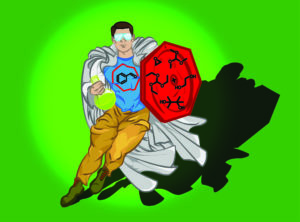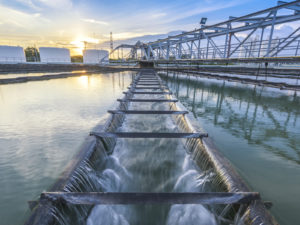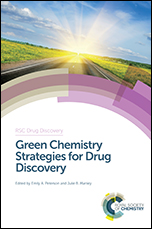As featured on the front cover of Green Chemistry Issue 17, Dr Vinh Nguyen tells us a little more about the artwork: “This graphic features a “superchemist” in safety goggles and white labcoat/cape holding a round-bottom flask. He is holding a heptagonal shield representing our tropylium ion. There are engravings on the shield denoting what chemicals can be used to protect the “carbonyl compound” on his chest.”
Archive for the ‘Uncategorized’ Category
Green Chemistry publishes: a new way to remove 99% of harmful BPA from water
Green Chemistry Review gains worldwide press coverage.
An international team of scientists have designed a water treatment system that can remove the harmful chemical BPA from water with 99% effectiveness – as published in Green Chemistry.
Dr Matthew DeNardo, one of the review‘s authors and the primary author of the BPA sections tells us about how the work came together:
The Institute for Green Science at Carnegie Mellon University, which is led by Terrence J. Collins, the Teresa Heinz Professor of Green Chemistry, focuses on the multidisciplinary development of TAML processes for the removal of endocrine disruptors from waters. Production of this authentic, high-quality work, requires engagement of the many fields necessary to direct chemistry towards sustainability. For example, this manuscript would not have been possible without significant contributions from The Department of Environmental and Molecular Toxicology at Oregon State University and both The Department of Civil & Environmental Engineering and Centre for Green Chemical Science at the University of Auckland.
The mini-reviews, which Dr. Collins and I wrote together, unify the findings of several disciplines concisely to illuminate the emergent truths. It is fitting that this ‘level of thought’ is necessary to both demonstrate the massive challenge facing the chemical enterprise and the path towards better chemical design and stewardship. Composing these sections, which was both necessary and right, was met with generous financial and moral support, an all-too-rare response for which I will be ever-grateful to Dr. Collins and the Heinz Endowments. I am also deeply indebted to all of the authors for their efforts and patience.
Read the original Green Chemistry publication here.
Find out more about the breakthrough from science outlets including Environmental Health News, Phys.org, New Scientist and RSC News.
Harvesting Renewable Energy with Chemistry themed collection now online
We are delighted to announce that the Green Chemistry themed collection on Harvesting Renewable Energy with Chemistry is now online and free to access until the end of July 2017.
Direct, efficient, and selective routes from renewable energies to targeted added-value chemicals are a crucial token of the necessary paradigm shift towards energy systems based on renewable resources. Guest-edited by Walter Leitner, Alessandra Quadrelli and Robert Schlögl, this special issue will highlight innovative concepts and recent developments in academia and industry at the interface between the energy and chemical sector.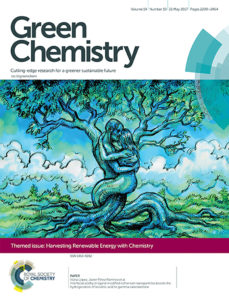
Read the full collection online
It includes:
Editorial
Harvesting renewable energy with chemistry
Walter Leitner, Elsje Alessandra Quadrelli and Robert Schlögl
Green Chem., 2017, 19, 2307-2308. DOI: 10.1039/C7GC90045G
Critical review
Structural models of the biological oxygen-evolving complex: achievements, insights, and challenges for biomimicry
Satadal Paul, Frank Neese and Dimitrios A. Pantazis
Green Chem., 2017, 19, 2309-2325. DOI: 10.1039/C7GC00425G
Critical review
Syngas production from electrochemical reduction of CO2: current status and prospective implementation
Simelys Hernández, M. Amin Farkhondehfal, Francesc Sastre, Michiel Makkee, Guido Saracco and Nunzio Russo
Green Chem., 2017, 19, 2326-2346. DOI: 10.1039/C7GC00398F
Communication
Earth-abundant photocatalytic systems for the visible-light-driven reduction of CO2 to CO
Alonso Rosas-Hernández, Christoph Steinlechner, Henrik Junge and Matthias Beller
Green Chem., 2017, 19, 2356-2360. DOI: 10.1039/C6GC03527B
Paper
Water splitting using a three-dimensional plasmonic photoanode with titanium dioxide nano-tunnels
Ryohei Takakura, Tomoya Oshikiri, Kosei Ueno, Xu Shi, Toshiaki Kondo, Hideki Masuda and Hiroaki Misawa
Green Chem., 2017, 19, 2398-2405. DOI: 10.1039/C6GC03217F
Paper
Continuous niobium phosphate catalysed Skraup reaction for quinoline synthesis from solketal
Jing Jin, Sandro Guidi, Zahra Abada, Zacharias Amara, Maurizio Selva, Michael W. George and Martyn Poliakoff
Green Chem., 2017, 19, 2439-2447. DOI: 10.1039/C6GC03140D
Green Chemistry 2017 Emerging Investigators themed issue now online!
We are delighted to announce that the inaugural Green Chemistry Emerging Investigators 2017 themed issue is now online and free to access until the end of August 2017.
This issue highlights the excellent research being undertaken by the rising stars of the green chemistry field from across the globe. All contributors were nominated by a member of the Green Chemistry Editorial or Advisory Board as an outstanding researcher in the early stages of their independent career, making a significant contribution to the advancement of green chemistry.
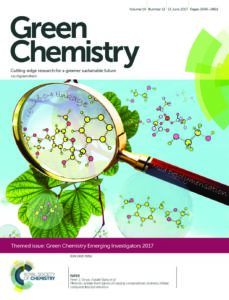 Congratulations to all of those whose work is featured in the collection and we hope you enjoy reading it.
Congratulations to all of those whose work is featured in the collection and we hope you enjoy reading it.
Read the full collection online
It includes:
Editorial
Green Chemistry Emerging Investigators 2017 themed issue
Green Chem., 2017, 19, 2707-2710. DOI: 10.1039/C7GC90063E
Perspective
Green chemistry and polymers made from sulphur
Max J. H. Worthington, Renata L. Kucera and Justin M. Chalker
Green Chem., 2017, 19, 2748-2761. DOI: 10.1039/C7GC00014F
Tutorial Review
Metal–organic frameworks meet scalable and sustainable synthesis
Patrick A. Julien, Cristina Mottillo and Tomislav Friščić
Green Chem., 2017, 19, 2729-2747. DOI: 10.1039/C7GC01078H
Paper
Phenolic acetals from lignins of varying compositions via iron(III) triflate catalysed depolymerisation
Peter J. Deuss, Christopher S. Lancefield, Anand Narani, Johannes G. de Vries, Nicholas J. Westwood and Katalin Barta
Green Chem., 2017, 19, 2774-2782. DOI: 10.1039/C7GC00195A
Paper
Biphasic extraction of mechanocatalytically-depolymerized lignin from water-soluble wood and its catalytic downstream processing
Gaetano Calvaruso, Matthew T. Clough and Roberto Rinaldi
Green Chem., 2017, 19, 2803-2811. DOI: 10.1039/C6GC03191A
Paper
Base-catalysed, one-step mechanochemical conversion of chitin and shrimp shells into low molecular weight chitosan
Xi Chen, Huiying Yang, Ziyi Zhong and Ning Yan
Green Chem., 2017, 19, 2783-2792. DOI: 10.1039/C7GC00089H
Continuous processing and flow chemistry in the pharmaceutical industry themed issue now online
We are pleased to announce the Green Chemistry themed issue on Continuous processing and flow chemistry in the pharmaceutical industry is now online.
Guest-edited by Stefan Koenig (Genentech, a member if the Roche Group) and Helen Sneddon (GlaxoSmithKline and Green Chemistry Editorial Board), this themed issue aims to showcase recent advances in the field of continuous processing and flow chemistry technology in drug discovery and development.
It includes:
Editorial
Recent advances in flow chemistry in the pharmaceutical industry
Stefan G. Koenig and Helen F. Sneddon
Green Chem., 2017, 19, 1418-1419. DOI: 10.1039/ C7GC9017A
Communication
The scale-up of continuous biphasic liquid/liquid reactions under super-heating conditions: methodology and reactor design
Francesca Mandrelli, Alessia Buco, Lorenzo Piccioni, Florian Renner, Bertrand Guelat, Benjamin Martin, Berthold Schenkel and Francesco Venturoni
Green Chem., 2017, 19, 1425-1430. DOI: 10.1039/C6GC02840C
Paper
Development of a concise, scalable synthesis of a CCR1 antagonist utilizing a continuous flow Curtius rearrangement
Maurice A. Marsini, Frederic G. Buono, Jon C. Lorenz, Bing-Shiou Yang, Jonathan T. Reeves, Kanwar Sidhu, Max Sarvestani, Zhulin Tan, Yongda Zhang, Ning Li, Heewon Lee, Jason Brazzillo, Laurence J. Nummy, J. C. Chung, Irungu K. Luvaga, Bikshandarkoil A. Narayanan, Xudong Wei, Jinhua J. Song, Frank Roschangar, Nathan K. Yee and Chris H. Senanayake
Green Chem., 2017, 19, 1454-1461. DOI: 10.1039/C6GC03123D
Paper
A laboratory-scale annular continuous flow reactor for UV photochemistry using excimer lamps for discrete wavelength excitation and its use in a wavelength study of a photodecarboxlyative cyclisation
Erica N. DeLaney, Darren S. Lee, Luke D. Elliott, Jing Jin, Kevin I. Booker-Milburn, Martyn Poliakoff and Michael W. George
Green Chem., 2017, 19, 1431-1438. DOI: 10.1039/C6GC02888H
Professor Khaled Belkacemi among shooting victims in Québec
The green chemistry community mourns the loss of Professor Khaled Belkacemi of Laval University in Québec, Canada. His contributions in the area of heterogeneous catalysis for biomass conversion and food chemistry help the drive to make the world a greener place. Unfortunately, violence against Muslims took his life at a mosque in Québec on the 29th of January. We mourn his passing, send our condolences to his family and colleagues, and hope that the future will bring us greater tolerance as well as a greener society.
Green Chemistry Impact Factor increases to 8.506
Green Chemistry is pleased to announce its Impact Factor has increased to 8.506*.
Green Chemistry continues to lead the field as the home of cutting-edge science for the development of alternative sustainable technologies. Our broad scope and the interdisciplinary nature of research published in the journal, coupled with our rigorous peer review and rapid times to publication, ensures your work will quickly attract the attention it deserves.
As we celebrate the Silver Anniversary of the green chemistry concept, our esteemed Editorial and Advisory Board members revisit the 12 principles of green chemistry and look ahead to the future of the field. Read the Editorials in our special online collection.
We would like to thank all our authors, readers, reviewers and Editorial & Advisory Board members for making Green Chemistry a unique forum for research that enables a greener sustainable future
*The Impact Factor provides an indication of the average number of citations per paper. Produced annually, Impact Factors are calculated by dividing the number of citations in a year, by the number of citeable articles published in the preceding two years. Data based on 2015 Journal Citation Reports® (Thomson Reuters).
Advisory board member Professor Sir Martyn Poliakoff wins Lord Lewis Prize
 Martyn Poliakoff is well-known both for his academic work and for his incredibly popular series of Periodic Videos. His research bridges the interface of chemistry and engineering, making chemical processes more environmentally friendly, by replacing the solvents used in reactions with greener alternatives. This work will provide society with more sustainable ways to produce the chemicals that we need. His major contribution has been in the use of supercritical fluids (gases compressed until they are as dense as liquids), particularly supercritical carbon dioxide or steam, as solvents for chemical reactions involving hydrogen or oxygen with organic compounds. The Lord Lewis Prize, which is awarded every two years, is given for distinctive and distinguished chemical or scientific achievements, together with significant contributions to the development of science policy.
Martyn Poliakoff is well-known both for his academic work and for his incredibly popular series of Periodic Videos. His research bridges the interface of chemistry and engineering, making chemical processes more environmentally friendly, by replacing the solvents used in reactions with greener alternatives. This work will provide society with more sustainable ways to produce the chemicals that we need. His major contribution has been in the use of supercritical fluids (gases compressed until they are as dense as liquids), particularly supercritical carbon dioxide or steam, as solvents for chemical reactions involving hydrogen or oxygen with organic compounds. The Lord Lewis Prize, which is awarded every two years, is given for distinctive and distinguished chemical or scientific achievements, together with significant contributions to the development of science policy.
To read more about Professor Sir Martyn Poliakoff and the 2016 Lord Lewis Prize please click-through to the website.
Related content:
All 2016 Royal Society of Chemistry prize and award winners: http://rsc.li/awards-prizes-2016
Collection of articles published by prize and award winners: http://rsc.li/rscwinners2016-collection
Green Chemistry Strategies for Drug Discovery
It is rapidly becoming clear that by incorporating green chemistry techniques earlier in drug development, pharmaceutical companies can greatly speed the production of a drug candidate.
Integrating green chemistry protocol into the drug discovery discipline is a relatively new phenomenon, as the scale at which chemists operate in drug discovery is smaller than in process and manufacturing chemistry.
Written by experts pioneering green chemistry efforts within their own institutions, Green Chemistry Strategies for Drug Discovery provides a practical guide illustrating to both academic and industrial labs how to implement greener process approaches for the greatest return on their investment, and without slowing down their science.
The Editors have taken a comprehensive approach to this emerging field, covering the entire drug discovery process from molecule conception, through synthesis, formulation and toxicology, with specific examples and case studies where green chemistry strategies have been implemented. They also address cutting-edge topics like biologics discovery, continuous processing and intellectual property.
Green Chemistry Strategies for Drug Discovery is the newest publication in the RSC Drug Discovery series. Further details on the content and scope of this book can be found on its Books Publishing page. If you like what you read, Green Chemistry Strategies for Drug Discovery is available now as a hardback from our Royal Society of Chemistry Bookshop. It is also in our 2015 eBook collection.
Recent HOT GC Articles
Check out the following HOT articles, these have all been made free to access for a limited time:
Recycling of rare earths from NdFeB magnets using a combined leaching/extraction system based on the acidity and thermomorphism of the ionic liquid [Hbet][Tf2N]
David Dupont and Koen Binnemans
Green Chem., 2015,17, 2150-2163
DOI: 10.1039/C5GC00155B
Upgrading biogenic furans: blended C10–C12 platform chemicals via lyase-catalyzed carboligations and formation of novel C12 – choline chloride-based deep-eutectic-solvents 
Joseph Donnelly, Christoph R. Müller, Lotte Wiermans, Christopher J. Chuck and Pablo Domínguez de María
Green Chem., 2015, Advance Article
DOI: 10.1039/C5GC00342C
From simple organobromides or olefins to highly value-added bromohydrins: a versatile performance of dimethyl sulfoxide
Song Song, Xiaoqiang Huang, Yu-Feng Liang, Conghui Tang, Xinwei Lia and Ning Jiao
Green Chem., 2015, Advance Article
DOI: 10.1039/C5GC00184F
Extraction and separation of neodymium and dysprosium from used NdFeB magnets: an application of ionic liquids in solvent extraction towards the recycling of magnets
Sofía Riaño and Koen Binnemans
Green Chem., 2015, Advance Article
DOI: 10.1039/C5GC00230C, Paper
Greening the global phosphorus cycle: how green chemistry can help achieve planetary P sustainability
Paul J. A. Withers, James J. Elser, Julian Hilton, Hisao Ohtake, Willem J. Schipper and Kimo C. van Dijk
Green Chem., 2015,17, 2087-2099
DOI: 10.1039/C4GC02445A, Perspective
Stimuli-responsive/rheoreversible hydraulic fracturing fluids as a greener alternative to support geothermal and fossil energy production 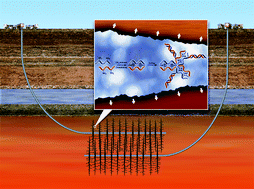
H. B. Jung, K. C. Carroll, S. Kabilan, D. J. Heldebrant, D. Hoyt, L. Zhong, T. Varga, S. Stephens, L. Adams, A. Bonneville, A. Kuprat and C. A. Fernandez
Green Chem., 2015, Advance Article
DOI: 10.1039/C4GC01917B, Paper
Fluorine gas for life science syntheses: green metrics to assess selective direct fluorination for the synthesis of 2-fluoromalonate esters
Antal Harsanyi and Graham Sandford
Green Chem., 2015, Advance Article
DOI: 10.1039/C5GC00402K, Paper
Layered MoS2 nanoparticles on TiO2 nanotubes by a photocatalytic strategy for use as high-performance electrocatalysts in hydrogen evolution reactions
Chenhui Meng, Zhaoyue Liu, Tierui Zhang and Jin Zhai
Green Chem., 2015, Advance Article
DOI: 10.1039/C5GC00272A, Communication
Ionic liquid-stabilized nanoparticles as catalysts for the conversion of biomass
K. L. Luska, P. Migowski and W. Leitner
Green Chem., 2015, Advance Article
DOI: 10.1039/C5GC00231A, Critical Review


